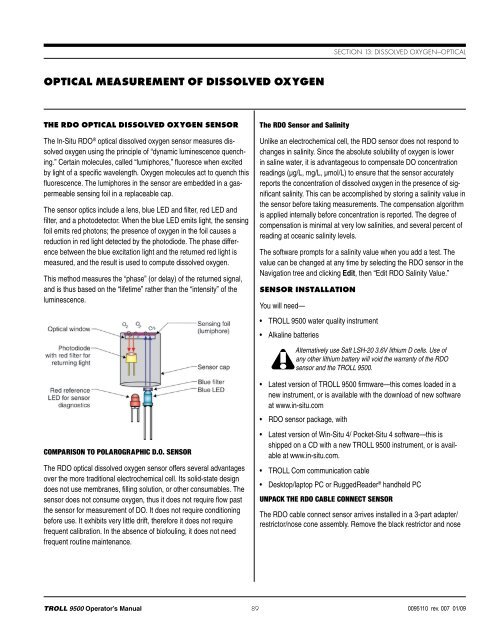TROLL 9500 Operator's Manual - Geotech Environmental Equipment
TROLL 9500 Operator's Manual - Geotech Environmental Equipment
TROLL 9500 Operator's Manual - Geotech Environmental Equipment
Create successful ePaper yourself
Turn your PDF publications into a flip-book with our unique Google optimized e-Paper software.
Section 13: Dissolved Oxygen—OpticalOptical Measurement of Dissolved OxygenThe RDO Optical Dissolved Oxygen SensorThe In-Situ RDO ® optical dissolved oxygen sensor measures dissolvedoxygen using the principle of “dynamic luminescence quenching.”Certain molecules, called “lumiphores,” fluoresce when excitedby light of a specific wavelength. Oxygen molecules act to quench thisfluorescence. The lumiphores in the sensor are embedded in a gaspermeablesensing foil in a replaceable cap.The sensor optics include a lens, blue LED and filter, red LED andfilter, and a photodetector. When the blue LED emits light, the sensingfoil emits red photons; the presence of oxygen in the foil causes areduction in red light detected by the photodiode. The phase differencebetween the blue excitation light and the returned red light ismeasured, and the result is used to compute dissolved oxygen.This method measures the “phase” (or delay) of the returned signal,and is thus based on the “lifetime” rather than the “intensity” of theluminescence.The RDO Sensor and SalinityUnlike an electrochemical cell, the RDO sensor does not respond tochanges in salinity. Since the absolute solubility of oxygen is lowerin saline water, it is advantageous to compensate DO concentrationreadings (µg/L, mg/L, µmol/L) to ensure that the sensor accuratelyreports the concentration of dissolved oxygen in the presence of significantsalinity. This can be accomplished by storing a salinity value inthe sensor before taking measurements. The compensation algorithmis applied internally before concentration is reported. The degree ofcompensation is minimal at very low salinities, and several percent ofreading at oceanic salinity levels.The software prompts for a salinity value when you add a test. Thevalue can be changed at any time by selecting the RDO sensor in theNavigation tree and clicking Edit, then “Edit RDO Salinity Value.”Sensor InstallationYou will need—• <strong>TROLL</strong> <strong>9500</strong> water quality instrument• Alkaline batteriesAlternatively use Saft LSH-20 3.6V lithium D cells. Use ofany other lithium battery will void the warranty of the RDOsensor and the <strong>TROLL</strong> <strong>9500</strong>.Comparison to Polarographic D.O. SensorThe RDO optical dissolved oxygen sensor offers several advantagesover the more traditional electrochemical cell. Its solid-state designdoes not use membranes, filling solution, or other consumables. Thesensor does not consume oxygen, thus it does not require flow pastthe sensor for measurement of DO. It does not require conditioningbefore use. It exhibits very little drift, therefore it does not requirefrequent calibration. In the absence of biofouling, it does not needfrequent routine maintenance.• Latest version of <strong>TROLL</strong> <strong>9500</strong> firmware—this comes loaded in anew instrument, or is available with the download of new softwareat www.in-situ.com• RDO sensor package, with• Latest version of Win-Situ 4/ Pocket-Situ 4 software—this isshipped on a CD with a new <strong>TROLL</strong> <strong>9500</strong> instrument, or is availableat www.in-situ.com.• <strong>TROLL</strong> Com communication cable• Desktop/laptop PC or RuggedReader ® handheld PCUnpack the RDO Cable connect SensorThe RDO cable connect sensor arrives installed in a 3-part adapter/restrictor/nose cone assembly. Remove the black restrictor and nose<strong>TROLL</strong> <strong>9500</strong> Operator’s <strong>Manual</strong> 890095110 rev. 007 01/09
















